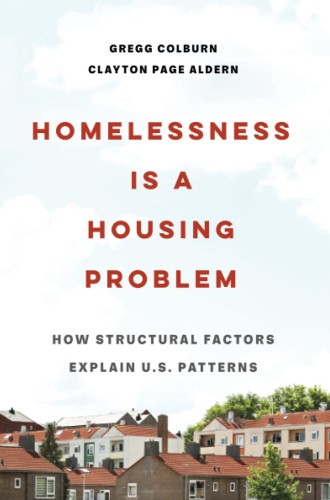The main characters in Homelessness Is a Housing Problem are not individuals experiencing homelessness; they’re cities. The book’s central question is this: What might explain the substantial regional variation in per capita homeless rates in the United States? The answers may not surprise everyone, but the authors’ route to their conclusions will both inform and inspire.
Gregg Colburn teaches at the University of Washington, where he studies housing policy, housing affordability, and homelessness. Clayton Page Aldern is a data scientist and policy analyst based in Seattle. If those bios make you wonder if this book is full of figures, tables, and endnotes, the answer is a resounding yes. While reading the first chapter, I texted a family member who works in statistics and said I might need her help. As I kept reading, however, I found the writing style very readable. The authors include stories, illustrations, and summary sentences with every argument, and I never grew frustrated or bored.
The data covers the 35 largest metropolitan statistical areas in the United States from 2007 to 2019. Colburn and Aldern begin by laying out the current state of knowledge about homelessness in the United States. Most importantly, they cover the relationship between structural racism and housing discrimination, the way we count people experiencing homelessness, and the various nonprofit and government agencies that track housing and homelessness statistics. They acknowledge throughout the book that the pandemic both exacerbated the housing crisis and led to some novel solutions.
Colburn and Aldern consider many explanations for the substantial variation in per capita homeless populations around the country. Their analysis of individual and household vulnerabilities and attributes (which include mental illness, drug use, and poverty) will be familiar to anyone who has sat in city council or planning and zoning meetings. At the metropolitan level, the authors show, homelessness is more a symptom of affluence than of poverty. Cities with a lot of wealth, such as Seattle and San Francisco, have a much greater homelessness problem than cities with more modest wealth, such as Detroit and Chicago. A section about the effect of race on homelessness concludes that “like other individual factors, race may explain who becomes homeless in a given city, but it doesn’t explain why one city has higher per capita rates of homelessness than another.” The authors next consider local culture and context (e.g., weather, politics, local welfare provisions). These factors also fail to explain regional variations.
Finally, Colburn and Aldern take up housing cost burdens, absolute rent levels, and rental market vacancy rates. And here they argue that rent levels and vacancies offer the most compelling explanation for regional variation in rates of homelessness. Colburn shares this example to illustrate:
If you’re a cost-burdened renter at the upper end of the income spectrum, you can choose to spend less on housing if the need arises. If you’re a cost-burdened renter at the lower end of the income spectrum, that’s not true. Rents don’t drop to zero. Instead, they hit a floor determined by the local housing context and the rules that govern housing quality.
Put more succinctly, there are simply more ways to “make it work” in St. Louis than in San Francisco.
In the final part of the book, the authors present responses to the housing crisis, focusing heavily on market factors. They question economic development agencies that bring employers and employees to a region while taking a “laissez-faire approach to housing these employees.” They also criticize cities’ reliance on single-family zoning: “Residential zoning is one of the seemingly innocuous rules and regulations that has played a major role in the housing crises that are gripping cities around the nation.” I wish the authors had talked more in this section about the monetary cost of the support part of permanent supportive housing, one of many solutions needed to solve homelessness, but it may simply have been beyond the scope of this book.
Throughout the text, Colburn and Aldern address the mindsets of cities and their citizens. Sometimes I find myself in conversations about solving the housing crisis that come down to this choice: one person thinks we could fix it all if we just changed the laws and structures, while the other person believes all we need to do is change everyone’s hearts. The truth is that we must do both. There are zoning codes, laws, and structures which need to be altered, but there is no sense changing them if our society does not collectively believe in the changes. Colburn and Aldern say as much in their final chapter: “First, a successful response will embrace homelessness as structural in nature, as opposed to a product of bad decisions or social deviancy; and second, it will see the people unhoused by this structure as fully human.”
Another powerful theme the authors return to is the de-commodification of housing. They write, “Rather than conceptualizing housing as solely a private good—one procured through market transactions—housing must be de-commodified. Shelter is fundamental to human survival and demands a different treatment than iPhones.” Viewing housing as a basic human right for all—rather than a means of income for landlords or a way for homeowners to build wealth—is one important way we can love our neighbor.
Colburn and Aldern offer many more gifts to their readers than I can convey in this review. There is plenty of material in the book for individuals wondering how to advocate for affordable housing, churches discerning giving or leasing land for housing, and communities that want to be proactive and avoid a housing crisis.





